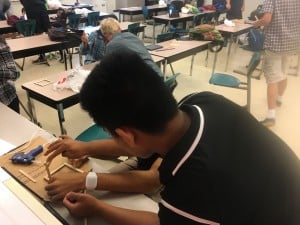Here in my 35th year of teaching, I think about some of my early experiences in my role as a teacher there was a lot of emphasis on What (scope) I taught and how it fit into the learning path of students (sequence). Most curriculum documents and textbooks are structured to map out the scope and sequence of a course of study. What often is left as an afterthought, or at least as a secondary action is How (pedagogy) that Scope and Sequence is delivered and by what means we assess success.
In 2012 I gave an Ignite Talk that was titled “Mobile Technologies & Personalized Learning: A quest to make thinking visible and technology invisible” (Slide Deck here). As a part of that talk, I emphasized that technology and pedagogy play an important role to move learners to a more personalized, powerful and lasting learning experience. The overlapping of Content, Technologies (tools), and Pedagogy is the place where where learning can be shaped.
In our work in the Mid-Pacific eXploratory (MPX) program we spend as much time planning for how students encounter their learning as we spend looking at what they will be learning. For example, in our recent work, we have our students designing and building trebuchets for a project we call “Santa’s Little Helper”. Although the underlying content is from the Integrated Science 1 in the Next Generation Science Standards (NGSS), our goal has been to create the conditions under which the students have an opportunity to create, make decisions, iterate, explain their work through real world activities and build in design and engineering as a part of the process.


This gives us a chance to create a classroom environment that has a strong culture of learning. In his recent wonderful book, Cultures of Thinking, Ron Richart lays out 8 Forces that must be part of learning to really transform classroom practice:
time, opportunities, routines, language, modeling, interaction, physical environment and expectations (more information here).
Note – none of these forces are the scope and sequence. However, they are just as important a component in the instructional design process for learning. In an earlier blog post, I discussed the “Pebble in the Pond” which is an instructional methodology that looks at whole problem learning. There are other frameworks that are structured like this – whether it is Wiggins and McTigue’s Backwards Design in UBD, the Buck Institute’s Gold Standard for PBL, or the TPACK framework for 21st-century learning.
Back in the 1990s when I was working with the ASU modeling instruction program for science education, it was impressed upon us that we were not learning a curriculum, we were learning a pedagogy of scientific inquiry. In much the same way, the work that we continue to do in our MPX program reflects that idea – that it isn’t just about what we learn (scope and sequence), but it is also important to consider how we learn.
